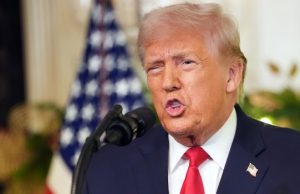
Earlier this week, President Trump introduced his latest defense strategy—dubbed the Golden Dome—during a national security briefing in the Oval Office. The $175 billion (£129 billion) plan involves deploying missile defense systems in space to safeguard the U.S. from foreign attacks.
Given Trump’s consistent focus on strengthening national defense and increasing military budgets, this announcement aligns closely with his broader presidential agenda.
Still, the project has sparked a range of reactions. Critics have questioned its feasibility and motives, with some suggesting it’s simply a way to funnel federal funds to Elon Musk and SpaceX.
Others mocked the concept, comparing visual representations of the defense system to the massive glass dome used to quarantine Springfield in The Simpsons Movie.

But what is the Golden Dome, and how is it supposed to work?
What is the Golden Dome?
Unveiled by President Trump on May 20, the Golden Dome is envisioned as an advanced missile defense system designed to shield the U.S. from airborne threats.
The idea is to build a protective umbrella over the country capable of neutralizing missile attacks launched from anywhere on Earth—or even space.
According to Trump, the system will rely on next-generation technology deployed across multiple domains: land, sea, and space.
He stated, “We have officially selected an architecture for this state-of-the-art system… including space-based sensors and interceptors.”

The goal is for the Golden Dome to be fully operational by the end of Trump’s second term in 2029. Major defense contractors such as Lockheed Martin, Boeing, and SpaceX are reportedly contenders for key roles in the project.
While Trump estimates the cost at $175 billion, many experts warn that the final expense could climb into the trillions.
How Will It Function?
Despite its name and the conceptual images displayed at the White House—showing a transparent dome over North America—the real Golden Dome will not be a physical structure.
Instead, it’s expected to function as a complex network of space- and ground-based systems.
The plan involves launching satellites that can detect and track incoming threats, such as missiles, and neutralize them using either land-launched interceptors or space-based defenses.

In concept, it resembles Israel’s Iron Dome—a land-based missile shield with a 90% interception success rate—but would extend to cover much broader and more advanced threats, including those from space.
Why Is It Needed?
In a recent executive order, the White House emphasized that the greatest existential threats to the U.S. include ballistic, cruise, and hypersonic missiles.
While the U.S. already has multiple air defense measures, such as the Patriot missile system and NORAD (the U.S.-Canada Aerospace Defense Command), officials argue that these may not be sufficient for future threats.
New technologies from nations like Russia and China, including hypersonic missiles and orbital bombardment systems, could evade existing systems due to their speed, unpredictability, and low-Earth orbit trajectories.

Trump’s administration insists that the Golden Dome will offer unmatched protection, with a slogan accompanying one of the concept images stating, “This is a Very Dangerous World. We’re going to protect our citizens like never before!”
Global Reaction
The announcement hasn’t gone unnoticed abroad. China and Russia have already voiced their opposition. A Chinese Foreign Ministry spokesperson expressed “serious concern,” stating that the plan contradicts the Outer Space Treaty, which promotes the peaceful use of outer space.
They accused the U.S. of seeking unilateral security at the expense of global stability.
Similarly, the Kremlin warned that such a move could disrupt global strategic balance. Russian official Dmitry Peskov stated that this development might necessitate renewed dialogue on strategic arms and global security measures.
In summary, Trump’s Golden Dome plan is a bold and expensive defense initiative aiming to revolutionize U.S. missile protection, but it comes with heavy controversy and international backlash.



















